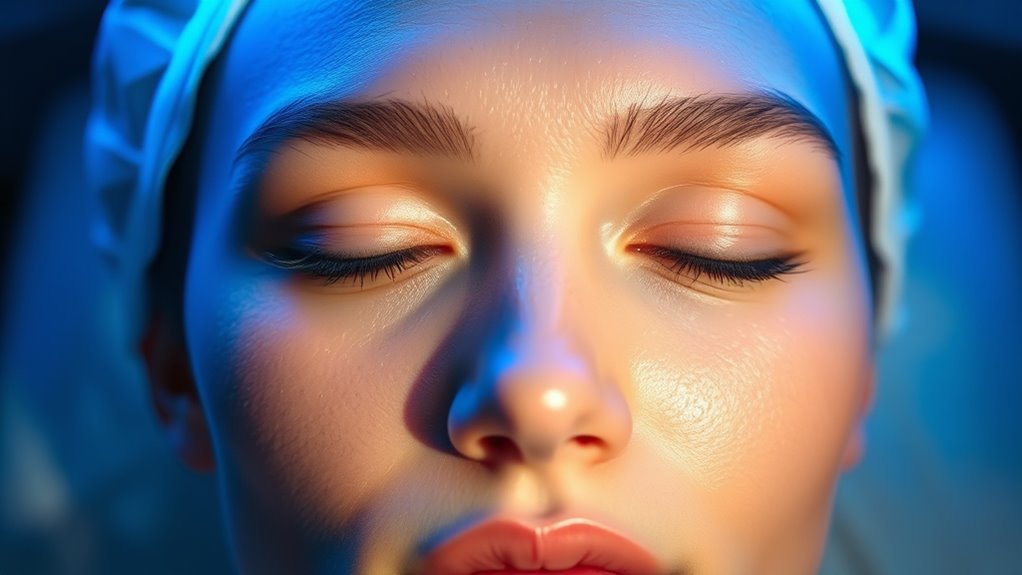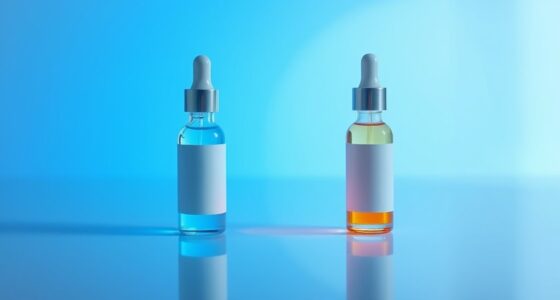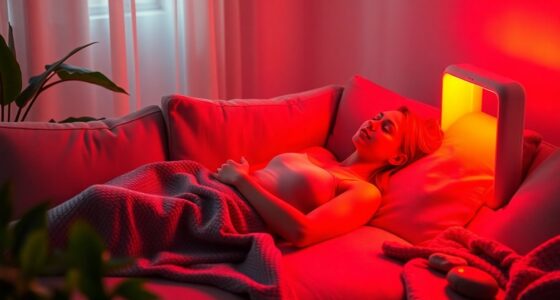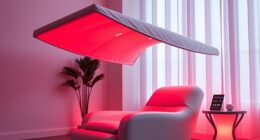Light therapy, especially red and near-infrared wavelengths, can boost your skin’s health by promoting cellular repair and strengthening your skin’s natural barrier. When used properly, it encourages collagen production, reduces inflammation, and helps your skin better retain moisture. However, overdoing it or using high-intensity treatments can cause irritation or weaken your skin’s defenses. To get the best results without harm, understanding how to protect your skin’s barrier is essential—if you stay informed, you’ll discover how to use light therapy safely and effectively.
Key Takeaways
- Proper light therapy supports skin cell repair and strengthens the skin’s natural barrier.
- Overuse or high-intensity treatments can damage or weaken the skin’s outer protective layer.
- Sensitive or compromised skin requires gentler approaches to avoid irritation and inflammation.
- Maintaining the skin barrier enhances moisture retention and protects against environmental stressors.
- Following professional guidance and recommended protocols ensures safe, effective light therapy benefits.

Light therapy has gained popularity as a non-invasive way to improve skin health, but many people wonder how it affects the skin’s natural barrier. Your skin barrier is fundamental for protecting against environmental damage, bacteria, and moisture loss. When you consider trying light therapy, understanding its impact on this barrier helps you make informed decisions. The good news is that, when used correctly, light therapy can support skin healing without compromising this essential defense system.
The key lies in how different types of light interact with your skin. For example, red and near-infrared light are often used for their anti-inflammatory and healing properties. These wavelengths penetrate deeply, stimulating cellular activity and promoting collagen production. This process can enhance your skin’s resilience, which in turn helps strengthen the barrier. Because these therapies are gentle and controlled, they usually don’t strip away natural oils or damage the outermost layer, known as the stratum corneum. When this layer remains intact, your skin continues to hold moisture and defend against pollutants and microbes.
However, not all light therapies are equally safe for your barrier. Overuse or exposure to high-intensity treatments can cause irritation or dryness, especially if your skin is sensitive or already compromised. For example, excessive UV-based therapies can break down collagen prematurely and weaken your skin’s defenses. That’s why it’s essential to follow recommended protocols and consult a skincare professional. Proper guidance ensures you benefit from the therapy without risking damage to your skin’s natural defenses.
Another factor that influences how light therapy interacts with your barrier is your skin’s current condition. If your skin is already irritated, inflamed, or broken, aggressive treatments might exacerbate these issues. In such cases, your practitioner may recommend gentler options or suggest waiting until your skin heals. Conversely, if your skin is healthy, light therapy can enhance its natural barrier function over time, making it more resilient against environmental stressors.
Ultimately, the relationship between light therapy and your skin barrier depends on proper application and your individual skin type. When used responsibly, light therapy can support your skin’s natural defenses by encouraging cellular repair and reducing inflammation. It’s essential to approach this treatment with care, listen to your skin’s responses, and seek professional advice if you’re unsure. By doing so, you can enjoy the benefits of improved skin health while maintaining a strong, protective barrier that keeps your skin healthy and vibrant.
Frequently Asked Questions
Can Light Therapy Cause Long-Term Damage to the Skin Barrier?
Light therapy typically doesn’t cause long-term damage to your skin barrier when used correctly. However, overuse or improper settings might lead to irritation or sensitivity. You should follow your practitioner’s guidelines and avoid excessive sessions. Always monitor how your skin responds, and if you notice prolonged redness or discomfort, consult a professional. Proper application minimizes risks, helping you enjoy benefits without compromising your skin’s health.
How Does Light Therapy Compare to Topical Treatments for Skin Barrier Repair?
Think of light therapy as a gentle whisper from the sun, compared to topical treatments‘ hands-on approach. Light therapy stimulates your skin internally, encouraging repair without physical contact, while topicals deliver ingredients directly to your skin’s surface. Both can effectively support your skin barrier, but light therapy offers a non-invasive option, reducing irritation risk. Your choice depends on your skin’s needs and how your skin responds to each method.
Are Certain Skin Types More Vulnerable to Light Therapy Effects?
Yes, certain skin types are more vulnerable to light therapy effects. If you have sensitive, fair, or already compromised skin, you might experience more irritation, redness, or discomfort after treatment. Skin that’s prone to conditions like rosacea or eczema can react more intensely. To protect yourself, consult a dermatologist beforehand, especially if your skin is delicate or reactive, so they can tailor the therapy to your needs.
What Is the Ideal Frequency and Duration for Effective Light Therapy Sessions?
Imagine the gentle glow of dawn, signaling a fresh start—your ideal light therapy session should last about 10-20 minutes, 3 to 5 times a week. This frequency allows your skin to adapt and benefit without overstimulation. Consistency is key, so stick with this routine for several weeks, and you’ll notice the positive effects on your skin’s health and appearance while minimizing irritation.
Can Light Therapy Improve Skin Barrier Function in Sensitive or Reactive Skin?
Yes, light therapy can improve your skin barrier if you have sensitive or reactive skin. It stimulates cellular repair and reduces inflammation, helping to bolster your skin’s protective layer. You should start with gentle sessions and gradually increase frequency based on your skin’s response. Always consult a dermatologist first to ensure the treatment suits your skin type and to avoid any adverse reactions that could worsen sensitivity.
Conclusion
So, next time you think light therapy is just a fancy trend, remember—it’s your skin’s ultimate superhero! It can fix, restore, and defend your skin barrier like nothing else. With every gentle beam, you’re revealing the secret to radiant, resilient skin that’s practically unstoppable. Don’t underestimate the power of light; it’s not just a treatment, it’s your skin’s new best friend. Embrace it, and watch your skin transform into an unstoppable fortress!








